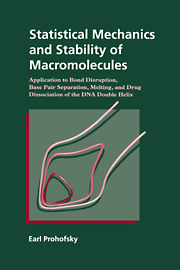 Statistical Mechanics and Stability of Macromolecules
Statistical Mechanics and Stability of Macromolecules Book contents
- Frontmatter
- Contents
- Preface
- 1 Introduction
- 2 Macromolecular stability
- 3 Lattice dynamics
- 4 Effective phonon theory
- 5 Premelting disrupted chemical bonds
- 6 Cooperative melting
- 7 Strained chemical bonds: salt and pressure effects
- 8 Bond disruption and conformation change: B to Z conformation change in DNA
- 9 Hydration effects: structural water
- 10 Helix with daunomycin intercalated: increased helix stability and daunomycin-DNA binding constant
- 11 Nonrepeating DNA
- 12 Cutting and splicing: junctions, inserts, and the replicating fork
- 13 Interaction between a helix and a single attached molecule
- 14 Energy considerations in bond opening
- Appendix 1 Helical lattice dynamics
- Appendix 2 Density matrix and effective phonon theory
- Appendix 3 Green functions
- References
- Index
8 - Bond disruption and conformation change: B to Z conformation change in DNA
Published online by Cambridge University Press: 16 September 2009
- Frontmatter
- Contents
- Preface
- 1 Introduction
- 2 Macromolecular stability
- 3 Lattice dynamics
- 4 Effective phonon theory
- 5 Premelting disrupted chemical bonds
- 6 Cooperative melting
- 7 Strained chemical bonds: salt and pressure effects
- 8 Bond disruption and conformation change: B to Z conformation change in DNA
- 9 Hydration effects: structural water
- 10 Helix with daunomycin intercalated: increased helix stability and daunomycin-DNA binding constant
- 11 Nonrepeating DNA
- 12 Cutting and splicing: junctions, inserts, and the replicating fork
- 13 Interaction between a helix and a single attached molecule
- 14 Energy considerations in bond opening
- Appendix 1 Helical lattice dynamics
- Appendix 2 Density matrix and effective phonon theory
- Appendix 3 Green functions
- References
- Index
Summary
Dynamics of conformation change
Biological macromolecules often undergo changes in shape carrying out their biological function. For example the action of muscle fibers involves a relative rotation of a section of a macromolecule. An important change in shape in DNA is the B to A conformation change that is caused by changes in the level of hydration of the helix. The A conformation is the low hydration form. In that transition no valence bonds, and likely no H-bonds, are even transiently disrupted. The change is mostly to the helicity of the helix, going from a complete turn in 10 base pairs to one in 11 base pairs. In the process the width of the helix increases, the length decreases, and the base pairs tilt away from the perpendicular to the helix axis (Saenger, 1984). Analysis of this transition has been carried out in the context of a soft mode displacive change transition (Eyster and Prohofsky, 1977; Lindsay et al., 1985). Displacive change is useful for transitions that involve continuous movement of atoms from one conformation to another, i.e. where the transition is second order. The mode that goes soft, in soft mode analysis, is related to the softening of the free energy barrier that separates the free energy minima as a function of order parameter, as discussed in a previous chapter.
- Type
- Chapter
- Information
- Statistical Mechanics and Stability of MacromoleculesApplication to Bond Disruption, Base Pair Separation, Melting, and Drug Dissociation of the DNA Double Helix, pp. 117 - 126Publisher: Cambridge University PressPrint publication year: 1995
- 1
- Cited by
